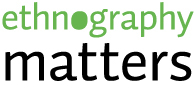On Digital Ethnography, What do computers have to do with ethnography? (1 of 4)
Editor’s Note: While digital ethnography is an established field within ethnography, we don’t often hear of ethnographers building digital tools to conduct their fieldwork. Wendy Hsu wants to change that. In the first of her three-part guest post series, she shows how ethnographers can use software, and even build their own software, to explore online communities. By drawing on examples from her own research on independent rock musicians, she shares with us how she moved from being an ethnographer of purely physical domains to an ethnographer who built software programs to gather more relevant qualitative data.
Wendy is currently a Mellon Digital Scholarship Postdoctoral Fellow in the Center of Digital Learning + Research at Occidental College. She recently completed a Ph.D. in the Critical and Comparative Studies program in the McIntire Department of Music at the University of Virginia. Her dissertation, an ethnography of Asian American independent rock musicians, deploys the methods of ethnomusicology and digital humanities to explore the complex interrelationships between popular music and geography in transnational contexts. She implemented methods of digital ethnography to map musicians’ social networks. She tweets at @wendyfhsu and blogs at beingwendyhsu.info. She also plays with the vintage Asian garage pop revivalist band Dzian!.
Check out past posts from guest bloggers. Here are some ideas for how you can contribute.
__________________________________________________
When Tricia asked me to contribute a series on Ethnography Matters, I thought that I would take this opportunity to bring together the notes on digital ethnography that I have collected over the last couple of years. I would like to push the boundaries of computational usage in ethnographic processes a bit here. I really want to expand the definition of digital ethnography beyond the use of computers, tablets, and smart phones as devices to interact with online communities, or to capture, transfer, and store field media.
In this three-part series, I am going to discuss how working with computational tools could widen the scope of ethnographic work and deepen our practice. I will stay mostly within the domain of data gathering in this first post. In the second post, I will talk about the process of field data interpreting and visualizing; and the last post, I will focus on how the digital may transform ethnographic narrative and argumentation.
In this post, I’d like to foreground computational methodology in thinking about how we as ethnographers may deploy digital tools as we explore communities within and around digital infrastructures. I am particularly interested in how we use these tools to study communities that are digitally organized. How do we use and think about data ethnographically? How does one use computational tools to navigate in digital communities? What are the advantages of leveraging (small) data approaches in doing ethnographic work? While this post is focused on the study of digitally embedded communities, in my later posts, I will speak more broadly about how the digital may extend how we look at communities where face-to-face interactions are central.






Recent Comments